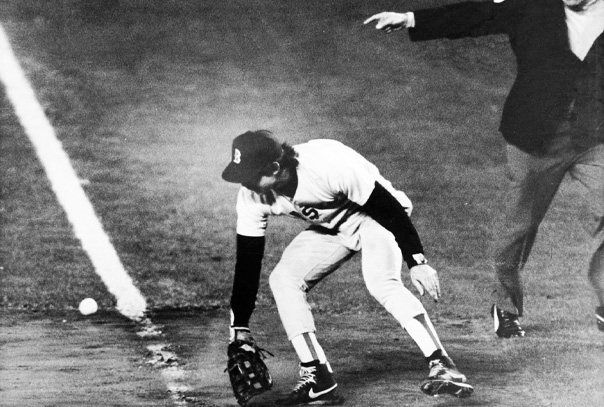 “Little roller up along first… behind the bag… It gets through Buckner! Here comes Knight and the Mets win it!”
“Little roller up along first… behind the bag… It gets through Buckner! Here comes Knight and the Mets win it!”
It’s one of the most iconic plays in World Series history. Vin Scully’s call of that final play of Game Six is one of baseball’s timeless soundbites. But without what happened just three pitches prior, the 1986 Fall Classic may have ended with a different winner and all that we remember today with such reverence just might have never been.
With the count 3-2 against Mookie Wilson and the Red Sox just one strike away from their first championship since 1918, Boston’s Bob Stanley uncorked a wild pitch that allowed the tying run to score from third. Because of the way that the game ended, etching itself in baseball lore forever, very few remember the wild pitch that not only tied the game, but it also allowed Ray Knight—the eventual winning run—to advance to second.
That wild pitch is the ultimate example of the play before the play: something that happens within a game that, without it, the big play might not even have a chance to take place.
As a Minor League manager across three levels for six years, one of my responsibilities was to simply teach the game to our younger players coming up through the system. While the bulk of their development was found in physical work on the field, it was important to make sure they understood where their physical talents fit within the flow of the game and how their ability to play the game and do the little things directly affected the end result.
Just about every day prior to team stretch, we would gather as a group to review the previous night’s game. Rather than lecturing the club about what I saw myself, it was important to get the players to see those things for themselves, so I would often open things up with the simple question, “alright guys… what do we get from yesterday? What was the most important play of the game?”
In the beginning, the players who spoke up would recognize the big, obvious plays that everyone at the ballpark would notice; the plays that were the next day’s headline like a walk-off homerun or a key strikeout to escape the bases loaded jam in the ninth. With a little guided line of questioning, like “what happened right before that home run,” or “why did the bases stay loaded just prior to the strikeout,” they began to understand what I was getting at. Hitters could see how that two-out, twelve-pitch walk extended the inning to allow the next hitter to even have the opportunity to step to the plate and send everyone home. Pitchers could grasp how the pitch up-and-in that went for ball two set up that huge strike three low and away.
Every single pitch and every single play in a game is its own experience. But the amazing thing about each one of those plays and pitches is how they can play a significant role in what happens next. Something as simple as an outfielder throwing to the correct base on a hit can be the reason a key double play is even possible against the very next batter. A great baserunning play to advance to third with less than two outs puts a team in a better position to score what may just be the game-winning run. A pitcher who backs up an errant throw and prevents a run from scoring in what ends as a one run victory. The many little plays that don’t show up in the box score but factored into the end score were the ones that our players needed to become aware of, in order for them to execute them better.
As they slowly caught on, they started to recognize those types of plays before the plays more and more. And the more they were recognized in those pre-game meetings, the more they were celebrated in the game when they happened, even if the “big” play didn’t follow. The more they learned the game through that lens, the better they played it… and that’s what player development is all about.